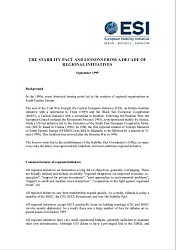De-INDUSTRIALISATION and its CONSEQUENCES. A Kosovo Story. (Lessons Learned and Analysis Unit of the EU Pillar of UNMIK European Stability Initiative)
De-INDUSTRIALISATION and its CONSEQUENCES. A Kosovo Story. (Lessons Learned and Analysis Unit of the EU Pillar of UNMIK European Stability Initiative)
Author(s): Author Not Specified
Subject(s): Local History / Microhistory, Transformation Period (1990 - 2010)
Published by: ESI – European Stability Initiative
Summary/Abstract: In pre-socialist times, the town of Peja (known in Serbian as Peć), was a lively regional centre of around 16,000 inhabitants, housing a community of merchants and craftsmen, several hotels and restaurants, and a few larger enterprises: a stream-driven flour mill, two timber mills and a small brick factory. Peja was first connected to the railway in July 1929 and electrification followed in the same year, with a small hydroelectric power-station on the White Drini River.
Today, after five decades of socialist development and more than ten years of post-socialist decay, Peja’s economy is back where it started early last century. Amid the ruins of an industrial sector which has entirely collapsed, one can find economic structures strikingly similar to those of the pre-socialist 1930s: shops, tradesmen, hotels, and a handful of functioning industries: a saw mill, a bakery, a brewery and a brick factory. The transition from a pre-industrial agricultural economy to an urban manufacturing centre has failed.
Series: ESI Discussion Papers
- Page Count: 22
- Publication Year: 2002
- Language: English
- Content File-PDF

